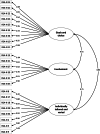Investigating the factor structure of a translated recovery-orientation instrument in inpatient treatment for substance use disorder
- PMID: 33741021
- PMCID: PMC7980679
- DOI: 10.1186/s13011-021-00363-0
Investigating the factor structure of a translated recovery-orientation instrument in inpatient treatment for substance use disorder
Erratum in
-
Correction to: Investigating the factor structure of a translated recovery-orientation instrument in inpatient treatment for substance use disorder.Subst Abuse Treat Prev Policy. 2021 Sep 22;16(1):72. doi: 10.1186/s13011-021-00411-9. Subst Abuse Treat Prev Policy. 2021. PMID: 34551804 Free PMC article. No abstract available.
Abstract
Background: Recovery has been outlined as a process of change through which involvement and empowerment enables individuals to reach their goals and aspirations. Recovery self-assessment (RSA) is an instrument that has been acknowledged as an applicable measure of recovery-orientation in services for people with mental health problems or substance use disorder (SUD). This study aimed to translate RSA from US English to Norwegian and to investigate the factor structure of the translated version (RSA-N).
Methods: A translate/back-translate procedure was used. Confirmatory factor analysis (CFA) was applied to investigate the factor structure of RSA-N in a sample of clinicians (n = 407) working in inpatient SUD treatment facilities.
Results: The results suggested that the hypothesised five-factor structure originally obtained by the developers showed an inadequate fit with the current data sample. RSA-N was modified and restructured by removing twelve misfitting items and combining factors with high covariance using data from one subsample. The alternative three-factor structure yielded an acceptable fit for the data from a second subsample. Acceptable alpha coefficients, suggesting good internal consistency, supported the adequacy of the three-factor structure.
Conclusions: Results from the present study are in line with previous findings, which have failed to replicate the hypothesised five-factor structure without modifications. Knowledge about the degree to which SUD services are recovery-oriented may contribute to SUD services' pursuit of establishing an inpatient treatment environment that fosters change and development of inpatients. The present study's findings imply RSA-N's potential as an instrument to assess recovery-orientation in inpatient SUD treatment.
Keywords: Confirmatory factor analysis; Recovery self-assessment; Recovery-orientation; Substance use disorder; Translate/back-translate.
Conflict of interest statement
The authors declare that they have no competing interests.
Similar articles
-
Work-Related Satisfaction among Clinicians Working at Inpatient Treatment Facilities for Substance Use Disorder: The Role of Recovery Orientation.Int J Environ Res Public Health. 2021 Jul 12;18(14):7423. doi: 10.3390/ijerph18147423. Int J Environ Res Public Health. 2021. PMID: 34299874 Free PMC article.
-
Psychometric Evaluation of the Dutch Version of the Substance Use Recovery Evaluator (SURE-NL).Eur Addict Res. 2025;31(1):13-22. doi: 10.1159/000541584. Epub 2024 Nov 8. Eur Addict Res. 2025. PMID: 39522511 Free PMC article.
-
A Factor Analytic Investigation of the Person-in-Recovery and Provider Versions of the Revised Recovery Self-Assessment (RSA-R).Eval Health Prof. 2017 Dec;40(4):505-516. doi: 10.1177/0163278716674247. Epub 2016 Oct 20. Eval Health Prof. 2017. PMID: 27765886
-
Change in psychosocial factors connected to coping after inpatient treatment for substance use disorder: a systematic review.Subst Abuse Treat Prev Policy. 2019 May 3;14(1):16. doi: 10.1186/s13011-019-0210-9. Subst Abuse Treat Prev Policy. 2019. PMID: 31053153 Free PMC article.
-
Systematic reviews of the effectiveness of day care for people with severe mental disorders: (1) acute day hospital versus admission; (2) vocational rehabilitation; (3) day hospital versus outpatient care.Health Technol Assess. 2001;5(21):1-75. doi: 10.3310/hta5210. Health Technol Assess. 2001. PMID: 11532238 Review.
Cited by
-
Correction to: Investigating the factor structure of a translated recovery-orientation instrument in inpatient treatment for substance use disorder.Subst Abuse Treat Prev Policy. 2021 Sep 22;16(1):72. doi: 10.1186/s13011-021-00411-9. Subst Abuse Treat Prev Policy. 2021. PMID: 34551804 Free PMC article. No abstract available.
-
Work-Related Satisfaction among Clinicians Working at Inpatient Treatment Facilities for Substance Use Disorder: The Role of Recovery Orientation.Int J Environ Res Public Health. 2021 Jul 12;18(14):7423. doi: 10.3390/ijerph18147423. Int J Environ Res Public Health. 2021. PMID: 34299874 Free PMC article.
References
-
- Davidson L, Tondora J, Lawless MS, O'Connell MJ, Rowe M. A practical guide to recovery-oriented practice: tools for transforming mental health care. New York: Oxford University Press; 2009.
Publication types
MeSH terms
LinkOut - more resources
Full Text Sources
Other Literature Sources
Medical
Miscellaneous


